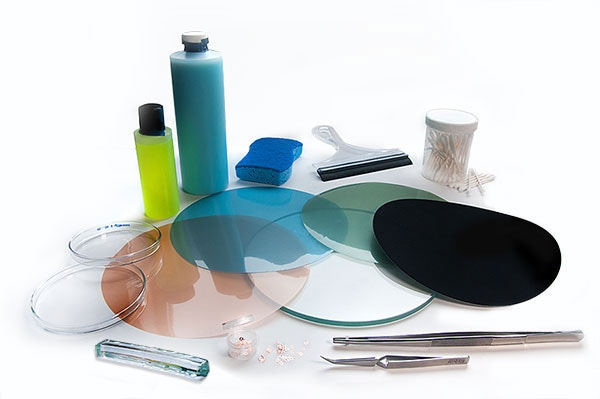The PELCO® Tripod Polisher™ 590 was conceived at the IBM East Fishkill Laboratory for the accurate preparation of specifically sized samples in the micron range for TEM and SEM analysis.
The PELCO® Tripod Polisher™ 590 can be used to prepare TEM samples with less than 15 minutes of ion milling or, in some instances, with no need for ion milling whatsoever. The system was originally designed to handle semiconductor cross-section samples; though it can also be used to produce cross-sections and plan-view samples from a variety of materials including metals, composites, ceramics and geological samples.
Features and Benefits
- The time taken to ion mill is reduced from hours to minutes
- Provides accurate cross-sectional TEM samples
- Repeatable TEM samples can be produced quickly
- Large thin areas can be created over the whole sample
Using the PELCO® Tripod Polisher™ 590
SEM and TEM cross-section samples can be produced using the PELCO® Tripod Polisher™ 590.
To create a TEM sample the original sample is attached to the face of a unique SEM stud, which is then fastened into the PELCO® Tripod Polisher™ 590s slotted L-bracket. Grinding is firstly carried out using a 15 μm metal bonded diamond disc, which is followed by more polishing and lapping using a range of diamond films of sizes between 30 μm to 0.5 μm and a final polish using a suspension of colloidal silica.
Throughout the lapping process the plane of the polish is adjusted using two rear micrometers. An inverted microscope is used to observe the process and to align the plane of polishing parallel to the plane of interest. It is also possible to move the SEM mount to an ion mill for the carrying out of milling to polish debris and fine scratches and to attain a good surface topography before analysis with an SEM.
Following SEM analysis the same area is prepared for TEM analysis – to achieve this the sample is mounted to a single aperture TEM grid. Following removal of the slotted L-bracket the TEM grid is mounted on a round sample mount that is attached to the polisher’s center were mechanical thinning takes place using a Diamond Lapping Film. During the thinning process an inverted microscope is used to examine the sample and to ensure thinning is taking place on the correct plane.
The sample is thinned to a diameter of 1 μm or less followed by ion milling of 15 minutes or less.
Operation - Wedge Technique
The preferential thinning and uneven surface topographies that can result from short ion milling times can make studying the interfaces between different materials difficult. This can be avoided by not carrying out any ion milling and instead using the wedge technique to mechanically thin the sample to electron transparency.
To carry out the wedge technique the SEM stud in the slotted L-bracket is replaced with a Pyrex® insert that the sample is fixed on. Following the correct plane of interest being reached the sample is taken out and mounted on the Pyrex® insert’s bottom. The back micrometers are then adjusted, with the micrometer closest to the sample moved back to give a wedge shape as the sample is thinned. The sample, which has the region of interest at the peak of the wedge, is then thinned from behind until the region of interest is around 1 μm thick.
A final polishing cloth, such as the MultiTex Cloth is used alongside a suspension of colloidal silica until thickness fringes can be observed, i.e. less than a few thousand angstroms of thickness. The sample is then taken from the Pyrex® insert and fixed to a single aperture TEM grid for TEM analysis.
PELCO® Tripod Polisher™ 590 Starter Kit
